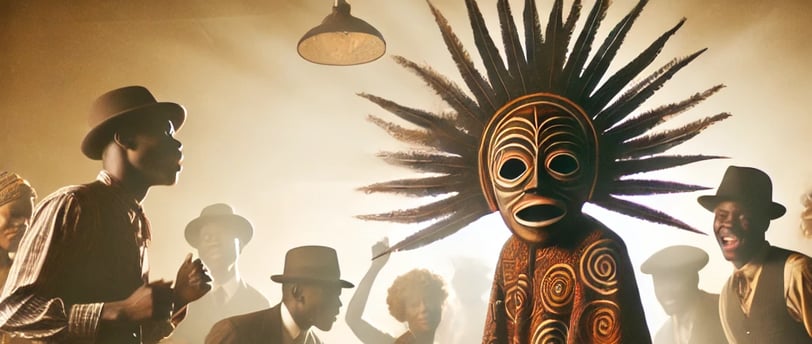The Dance Mythology of the 'Sinners' Movie
Describing the collected mythologies of the 'Sinners' movie. This part 2 and is about Dance Mythologies
4/28/20252 min read


Part 2
The Mythology of 'Sinners' - The Movie
Yesterday we reviewed the Smokestack Mythology of the Sinners Movie, which was a groundbreaking movie that deployed several mythical archetypes.
Today we look at an additional three.
The Mythology of the Dance
There came a moment when the music rose — and it was no longer music but a river, a storm, a multiversal invocation. The dancing began.
And every Black soul — every soul whose feet have ever lost themselves to beat and body, in a club, in a house, in a clearing, by a shore — was there.
Ancestors danced behind them, unseen but known.
Descendants danced ahead of them, yet unborn but certain. All in a moment of unparalleled freedom and indescribable joy and a shared attachment to the music and the voice that bore them weightless on the sound of music, ancient, modern and future.
And all time collapsed.
This was the mythology of movement,- the sound fusing with our souls, the music fusing with our minds and the beat becoming one with the beating of our hearts - in the sacred act of dance, by which we remind ourselves and the world that we have never stopped living, that our joy has never been defeated, that our bodies are memory made flesh.
The Mythology of the Masquerade
Then the Chinese Spirits twirled by! The masquerade made an appearance with its attendant spirits.
When the Chinese spirits danced through — when the masquerade crossed into the frame — the mythology grew even greater.
It said: You are not alone.
It said: Suffering and survival and sacredness are not the sole property of one people.
It said: The spirit world is a chorus, and every nation has sent its singers.
That masquerade is a shout across time: that though our roads have been cruel and our songs broken, somewhere beyond the blood and the burning, we still find each other in the dance.
And ironically, it was a mythology that found echo, and was mirrored by the Mythology of Irish dance and ditties that would shortly unfold outside the juke joint.
The Irish Mythology
Those first three vamps— the ones who asked for entrance —when they broke into song, they broke my heart – when they broke into Irish dancing, the cinema walls fell down around me.
Because their mythology was sung too.
When the Remmick broke into Irish dancing and the others followed, the air itself shifted. In the promissory notes of the music were carried Irish mythologies of loss. Of famine. Of forced migration. Of songs sung across oceans. They have danced their own dances of grief, fought their own battles of oppression and famine and flight.
And when they danced — the ancient jig, the riverdance born from sorrow and celebration alike, they called to a time when their people, too, were seen as less-than. When they, too, were forced to decide between survival and soul. And so they were saying, join us - we have found freedom – you will find it with us too, in our undeath state. There is a chilling symmetry here, which was no less chilling for the cheerful ditties to which they danced as they invited the living to die. Their dance was a testament: We, too, remember. We, too, have danced defiance into the ground.
Ryan Coogler honoured their mythology too. The griot was faithful to it all.
He showed that no pain is singular. He showed that while histories differ, grief is a universal tongue — and so is survival. Sometimes these mythologies of survival brush fingertips across each other, even through the blood and sorrow that history built between us. It was on this that the recruiter based his sales pitch to undeath, and it proved strangely compelling to those listening.
Culture
Unearthing Africa’s myths, history, and stories together.
Legends
Heritage
© 2024. All rights reserved.
© Chinenye Egbuna Ikwuemesi 2025.
All rights reserved.
The Afrodeities Codex and all associated titles, stories, characters, and mythologies are the intellectual property of the author. Unauthorized use is strictly prohibited.
